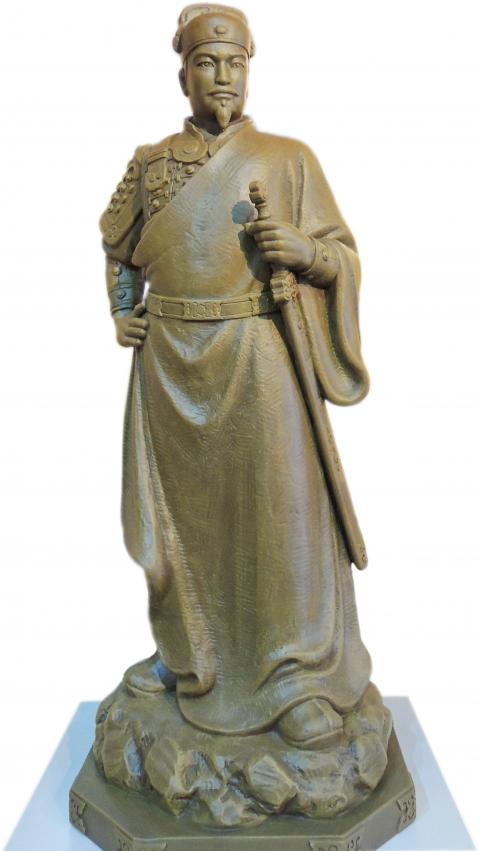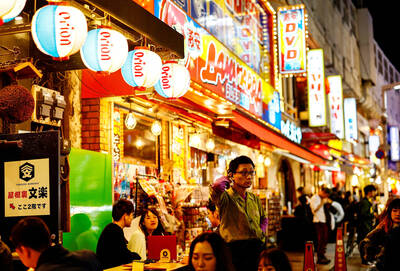Taiwan in Time: Aug. 24 to Aug. 30
While Cheng Cheng-kung’s (鄭成功) claim to fame is driving the Dutch out of Taiwan and is worshiped in several local temples, his legacy is a complicated one to define.
Born on Aug. 27, 1624 in Japan to a Chinese father and Japanese mother, Cheng joined his father in China when he was seven.

Photo: Meng Ching-tzu, Taipei Times
The Ming Dynasty fell in 1644, and Cheng’s father and his pirate fleet were tasked with defending Fuzhou (福州), the fallen empire’s last stronghold. It was during this time that Emperor Longwu (隆武) gave him the name Cheng-kung, meaning success, and granted him use of the royal last name Chu (朱) and the title of Guoxingye (國姓爺), literally Lord of the Imperial Surname, spelled in the West as Koxinga.
Cheng’s father defected to the Qing Dynasty in 1646, but Cheng remained loyal to the Ming and resisted the invaders until 1661, when he was forced out of China and headed to Taiwan, which was then under Dutch control with a predominantly Aboriginal population.
Intending to use Taiwan as a base to retake China, Cheng landed near Tainan, conquered Fort Provintia (in today’s Tainan) and ended 38 years of Dutch rule by capturing Fort Zeelandia (today’s Tainan) after a nine-month siege.
Cheng renamed Taiwan Tungtu (東土) and established a Ming-style government. To feed his 30,000 followers, his administration started large-scale land developments for farming carried out by his troops. Cheng died less than two years later at age 39, but his family continued to rule Taiwan for the next 20 years.
Legacy claimed by many
Cheng’s legacy is a complex one, having been long-used as propaganda by Japan, China and Taiwan. For each viewpoint, there seems to be a contradictory proposal.
The Qing Dynasty initially saw Cheng as an anti-government rebel, listed by Qianlong Emperor as a “rebellious subject” (逆臣). Near the end of the dynasty, Cheng was not only revived as a symbol of resistance against the West, but also revered by revolutionaries as an anti-Manchu hero to fuel their cause. This was the beginning of his status as a “national hero” (民族英雄).
Up until recent decades, he was consistently seen in both Taiwan and China as a hero who “recovered” Taiwan from “foreign” rule. Yet, recovered for whom? Taiwan was not part of China until the Qing government annexed it by defeating Cheng’s grandson in 1683.
If recovering Taiwan isn’t accurate, some also see Cheng as the “father of Taiwan’s development” (開台始祖), which doesn’t do justice to the Aboriginals, some of whom have protested his legacy in recent years.
Due to his heritage, Japan also sees Cheng as a native son and used his Japanese heritage as propaganda during its occupation of Taiwan. At the same time in China, his name was invoked as inspiration to expel the Japanese.
After the Chinese Nationalist Party (KMT) retreated to Taiwan, its leader Chiang-Kai Shek (蔣介石) used the similarity of their goals of using Taiwan as a base to reclaim China to maintain public support for his agenda. Conversely, the People’s Republic of China’s government saw him as a hero who liberated Taiwan for the motherland.
Another view gaining popularity nowadays is that Cheng is seen as the founder of the first Han Chinese government in Taiwan, leading the first large-scale Chinese migration and serving as a catalyst for increasing Chinese influence and presence in the country.
These are only the major talking points, and there are many other nuances regarding Taiwan’s identity that talking about Cheng may bring up. While he isn’t the only historical figure whose legacy will differ depending on whom you speak to, it is clear that he changed the fate of Taiwan when he took on the Dutch.
Taiwan in Time, a column about Taiwan’s history that is published every Sunday, spotlights important or interesting events around the nation that have anniversaries this week.

On April 26, The Lancet published a letter from two doctors at Taichung-based China Medical University Hospital (CMUH) warning that “Taiwan’s Health Care System is on the Brink of Collapse.” The authors said that “Years of policy inaction and mismanagement of resources have led to the National Health Insurance system operating under unsustainable conditions.” The pushback was immediate. Errors in the paper were quickly identified and publicized, to discredit the authors (the hospital apologized). CNA reported that CMUH said the letter described Taiwan in 2021 as having 62 nurses per 10,000 people, when the correct number was 78 nurses per 10,000

May 5 to May 11 What started out as friction between Taiwanese students at Taichung First High School and a Japanese head cook escalated dramatically over the first two weeks of May 1927. It began on April 30 when the cook’s wife knew that lotus starch used in that night’s dinner had rat feces in it, but failed to inform staff until the meal was already prepared. The students believed that her silence was intentional, and filed a complaint. The school’s Japanese administrators sided with the cook’s family, dismissing the students as troublemakers and clamping down on their freedoms — with

As Donald Trump’s executive order in March led to the shuttering of Voice of America (VOA) — the global broadcaster whose roots date back to the fight against Nazi propaganda — he quickly attracted support from figures not used to aligning themselves with any US administration. Trump had ordered the US Agency for Global Media, the federal agency that funds VOA and other groups promoting independent journalism overseas, to be “eliminated to the maximum extent consistent with applicable law.” The decision suddenly halted programming in 49 languages to more than 425 million people. In Moscow, Margarita Simonyan, the hardline editor-in-chief of the

Six weeks before I embarked on a research mission in Kyoto, I was sitting alone at a bar counter in Melbourne. Next to me, a woman was bragging loudly to a friend: She, too, was heading to Kyoto, I quickly discerned. Except her trip was in four months. And she’d just pulled an all-nighter booking restaurant reservations. As I snooped on the conversation, I broke out in a sweat, panicking because I’d yet to secure a single table. Then I remembered: Eating well in Japan is absolutely not something to lose sleep over. It’s true that the best-known institutions book up faster